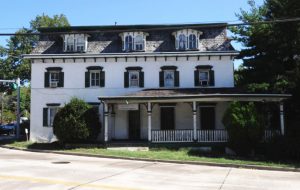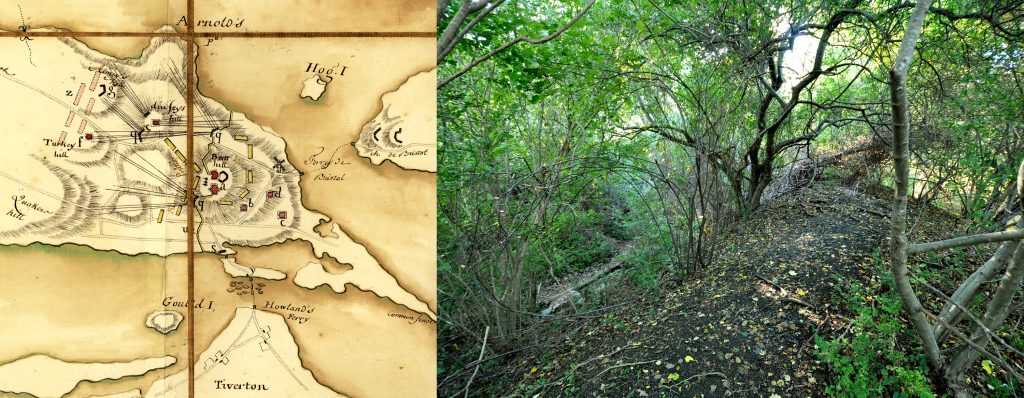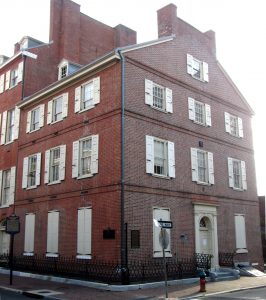A recent article mentioned Sidman’s Tavern in New Jersey, a building with strong connections to the American Revolution that is under threat of destruction. That compelled us to ask our contributors:
“Which historical structure related to America’s founding that is currently not recognized by a foundation, group, or organization do you think deserves preservation?”
While some responses refer to sites rather than existing structures, all are thought-provoking.
Gregory J. W. Urwin
The Bonnell Tavern in Clinton, New Jersey, should be preserved. Nothing epochal ever happened there, but the tavern facilitated the kind of localized activity that called the Revolution into being and kept it alive for eight years. Established in 1767 by Abraham Bonnell, an early leader in the Whig cause, the tavern shifted from a tool for politicizing the populace to one of military mobilization. It witnessed the organization of New Jersey’s first regiment of “minutemen” and became a center for recruiting Continentals. The 2nd Hunterdon County Militia Regiment, whose lieutenant colonel was Abraham Bonnell, also made the tavern its headquarters. For more about the tavern, see: www.bonnelltavern.com/.
Conner Runyan
The historical structure most deserving of preservation, currently not recognized by a foundation, group, or organization, would be White Hall Plantation, in what is now Greenwood County, South Carolina. Near Hard Labor Creek, close to the crossing of two great paths, the Barksdale Ferry Road and Five Notch Road, White Hall was the backcountry home and headquarters of Brig. Gen. Andrew Williamson, the so-called Benedict Arnold of the South. Today’s “Whitehall Crossroads,” as it is still known, is a nondescript rural intersection, sadly affected by over two centuries of agriculture, forestry, road construction, rural farmsteads and residences. Despite two recent (2011 and 2019) walkover surveys by local and regional historians, assisted by archaeologists and primary source materials, no significant archaeological evidence of White Hall has been found. Yet White Hall was called by one contemporary the most impressive plantation of its kind in the South. It functioned as a refugee fortress from the Cherokee, a patriot military outpost in close proximity to Ninety Six, as the site of surrender of the last major organized patriot force following the 1780 Fall of Charleston, and afterwards was a major British supply depot. A well-funded, systematic archaeological survey to locate White Hall is needed.

Gene Procknow
Bogart’s Tavern/General Greene’s Inn in Buckingham, Pennsylvania. A few miles east of New Hope, Pennsylvania and Coryell’s Ferry over the Delaware River sits a Mansard-roofed, two and one-half story tavern. Dating back to 1763, the building hosted many significant Revolutionary era events. Initially, the inn served as a regular meeting place for the Bucks County Committee of Safety and the muster site for the local militia. Most famously, it served as Maj. Gen. Nathanael Greene’s headquarters during the Trenton campaign of December 1776. In the twenty-first century, the building housed an eclectic antique store. However, the shop recently closed, and the building is falling into considerable disrepair. Without significant restoration, this beautiful and historically important building will be lost to future generations.
Will Monk
A few days before Washington’s Crossing, the Hessians went south from Bordentown to Mount Holly, New Jersey—twenty miles from Trenton. There was a skirmish in the fields near Petticoat Bridge Road (that’s the real name), in which the rebels hid in a brick house and allegedly put their bloody hand prints on the wall. The privately-owned house still stands on a quiet road, but it would be a nice little state historic site.
Don N. Hagist
On the northern end of Aquidneck Island in the state of Rhode Island is a hill that was named Windmill Hill during the three years that British forces garrisoned the island during the American Revolution. They built a substantial redoubt – an earthen fort – on the hill, with a commanding view of the mainland to the north and east. It was briefly ceded to American troops in 1778, then razed and abandoned when the British left in 1779. American troops quickly rebuilt on the site, and it was also occupied by French forces in 1780. Today the site is called Butts Hill, the ditches and earthen walls are largely intact, but the site is heavily overgrown and at risk of eroding into nothingness.

John Knight
Fishkill Supply Depot burial ground, Duchess County, New York. Just twenty minutes from my home lies a practically unknown cemetery that held thousands of bodies by the end of the war and is the largest Revolutionary War burial ground in America. It is also the last resting place of an unknown number of British redcoats whose bodies “were stacked liked cordwood.” This Hallowed ground should mark the selflessness and sacrifice characteristic of the founding of the United States. Instead, much of it has already been despoiled by a shopping arcade and what remains lies in peril of further development. This site needs to be properly honored and preserved.

Timothy Symington
There is one historical site in Boston that I believe should be recognized. Governor Thomas Hutchinson had a mansion near the Hanover Street and North Square section of Boston, and at the time it was one of the most elegant in the colonies. Because of his law and order policies, the mansion was almost destroyed by Stamp Act protestors in August of 1765. Hutchinson and his family just barely escaped the mob. The event was a major demonstration and shows the popular attitude towards supporters of British tax policy in Massachusetts. The house was taken down finally in 1834, but there should be a marker at least to acknowledge the effects of popular agitation.
Michael Cecere
Here in Virginia, there is a portion of the Washington-Rochambeau route that still exists in its “original” condition (minus the trees that grow in it). Yes, much of the route has been straightened, paved over, and marked, but there is a deep road cut that runs through Prince William Forest for almost a mile that is virtually untouched and has never been paved. There is another stretch of old colonial road here in Williamsburg next to a water park that should be preserved. The allied armies marched to Yorktown in 1781 along this route.

Nichole Louise
The childhood home of Peggy Shippen, who would go on to become the wife of Benedict Arnold. Originally built around 1750, the Shippen-Wistar House at 238 S. 4th St in Philadelphia saw several famous faces of the American Revolution – not just Peggy and Benedict Arnold, but also John Andre and officers from both sides of the conflict, as the Shippen family was technically neutral due to their Quaker background. The Shippen-Wistar House was previously owned by the Episcopal Diocese of Pennsylvania for office space until they sold it in 2014 to a condo developer. I shudder to think of this historically rich location being torn down for an apartment building! The Shippen-Wistar House, with the proper support, could serve as a great museum not only showcasing the life of a famous family in a grand eighteenth-century home, but also what Philadelphia was like during the Revolution and British occupation of Philadelphia.
William M. Welsch
The Trenton Battle Monument, which is administered by the state of New Jersey, is not a relic of the revolution as such, but is 126 years old and on the National Register of Historic Places. It is badly in need of upgrade and maintenance, as the state seems to simply ignore it, citing lack of funds. To my knowledge, no support group exists. The view from the top provides an excellent overview of the pivotal battle of Trenton. It’s current state and accessibility is a disgrace.
David M. Griffin
There is an American Redoubt ruin on the west side of Manhattan that was an outwork from Fort Washington in 1776. Today it is pretty much a derelict site with an overgrown path that is not maintained. I understand that it is the last visible earthwork from the Revolutionary War left on Manhattan Island. It is located in today’s Fort Washington Park. There is a stone monument on the site commemorating the location which was placed there by the Daughters of the American Revolution in 1910. The site deserves to be properly studied, researched and recorded and a plan for preservation be set. As one of the last vestiges from the extensive battles and fortifications around New York from 1776, it is a sole survivor in Manhattan.
We invite readers to suggest other historical sites of the American Revolution and Founding Era deserving of preservation.








13 Comments
An equally important question, unfortunately, is what significant buildings already under protection are being neglected and allowed to deteriorate? One answer is the structures in Washington Crossing Historic Park PA. Through years of neglect, historic buildings (including a tavern that may have a connection to Washington’s Crossing & an entire early 1800s village) are rotting, unsightly & safety hazards to visitors. Responsibility of PA Dept of Conservation & Natural Resources & Friends of Washington Crossing Park. I’m there frequently & can see harm occurring every season.
Amazing!
I have lived very near to Sidman’s Tavern (in the photo at the heading of the article) in Clinton, NJ, for the past 23 years, and I pass it several times a week. If memory serves me, the historic marker along the road indicates that a regiment of minute men was mustered in there. I always wondered what other significance it may have had, and now thanks to you I know. I always hoped the Fed or State might spruce it up, but I guess there is no available funding. It would be great if we could do something to preserve it. I would definitely contribute. Thanks for all the great Revolutionary War info!
I’m pleased to report that there is a plaque marking the site of Gov. Thomas Hutchinson’s house in the North End of Boston. It’s on Garden Court, so a little out of sight. See: https://www.hmdb.org/marker.asp?marker=18071
As a Trentonian who as a child walked to and from school daily past the Battle Monument I heartily agree. It was there sitting on the step I gained my love and appreciation of the American Revolution. I’d close my eyes and imagine that battle. To know that I now sat on the very ground where Washington, Hamilton, Greene and notable others once trod and fought that fateful December day was an honor even a small schoolgirl could feel.
Its elevator hasn’t been operational for years and the park is often the site of vandalism. I still visit and feel the reverance of that place but if something isn’t done soon I fear it will be lost.
Considering the current status of history in our education system. I wonder if we could set up a tax item on IRS return’s for those with this interest to charge an amount to go a fund to support such locations. I mean you can pick from a number of things to give money too , why not American Revolution locations???
That’s an awesome idea!
Most recently, McCrady’s Tavern, in downtown Charleston, SC, the building that houses the “Long Room” where George Washington and many dignitaries dined has been closed for business. The Neighborhood Dining Group will be putting it up for sale soon. It is designated a National Historic Site but what happens in the future is a question.
The “Long Room” has been until now used for dining as it was during the late 1760’s.
Hopefully it will remain intact and be used again for historic dining.
Contact American Battlefield Trust for help in preserving these sites:
American Battlefield Trust
Hi Don,
Thank-you for your addition on Windmill Hill. I have much wondered if ruins existed at this site after studying the period drawings of the British works. The drawings are art unto themselves. I am glad that there are still remains that can be analyzed and preserved, and feel this is an important and needed effort! The barrack structure from the British period I think a significant and unique structure, one of a kind. I wonder if it is accessible? Now that I know these remains exist I need to make a visit! TY.
There is nothing remaining of any British barracks in Rhode Island – those were burned to the ground by the British themselves when they left the island in October 1779, rather than leave them to the enemy. Only the ditches and earthen walls of the redoubt remain, quite visible although heavily overgrown. The site is very much worth the visit, to see the earthworks and the advantage of the ground chosen.
I assume you already know about The Old 1776 Tavern in Tappan? It is already land marked but is worth noting because it is still a wonderful working tavern and restaurant which has documented its storied history! https://76house.com/about/
Built in 1723, The Three Tuns Tavern (now the Mill St. Tavern) in Mount Holly, New Jersey is said to be the oldest continuous watering hole in the United States. In 1776 and 1778, it is likely the British/Hessians who encamped in town used the building for lodgings. The building is in remarkable shape for its age, and with the right attention paid to it by a historically-minded future owner, it could become a pivotal stop for local tourism and Revolutionary War enthusiasts.
It appears that the Shippen House is for sale again if anyone has $1.8 mill lying around…. https://www.zillow.com/homedetails/240-S-4th-St-Philadelphia-PA-19106/2106843233_zpid/?